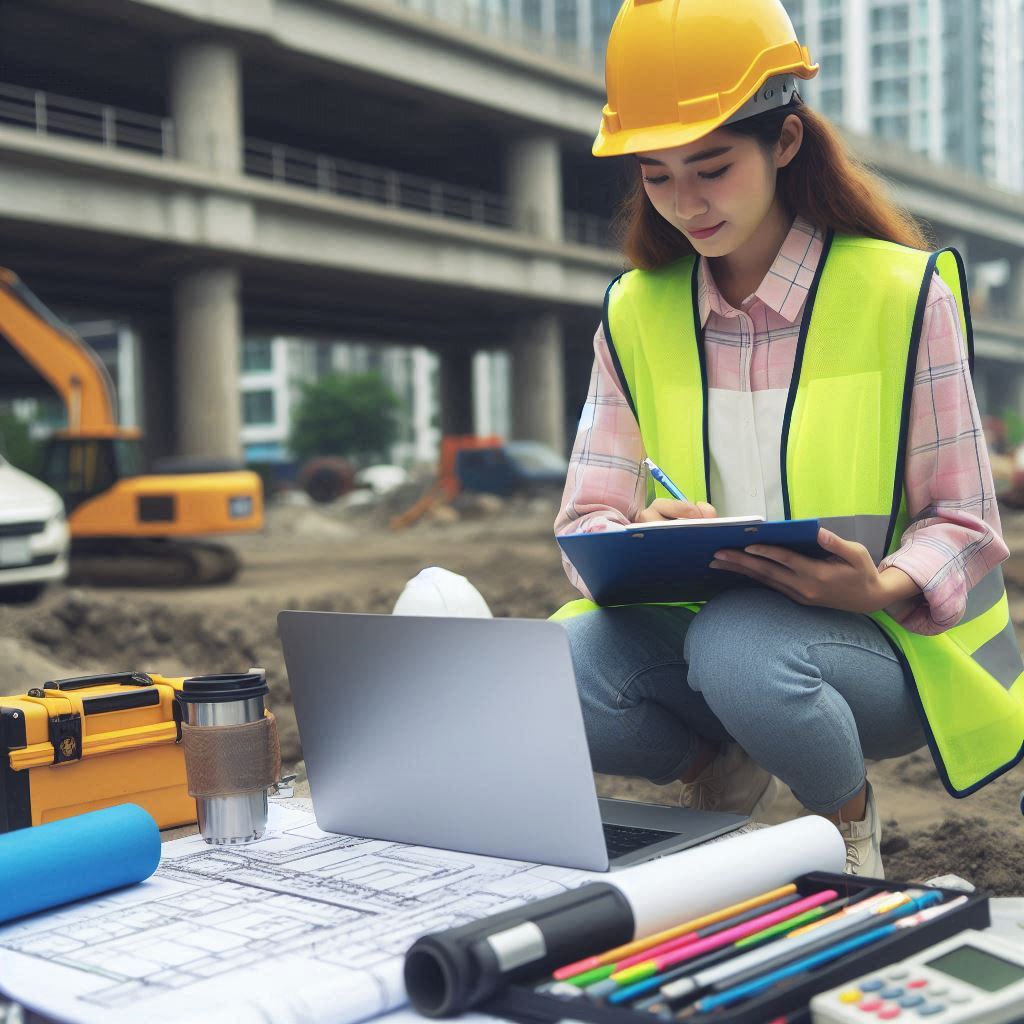Introduction
Geotechnical engineering is a crucial branch of civil engineering that focuses on the behavior of soil and rock in relation to construction and environmental projects.
It involves analyzing soil properties, rock mechanics, and groundwater conditions to ensure the stability and safety of structures built on or within the earth.
This field addresses the interaction between the ground and engineered structures, making it essential for a wide range of applications.
The importance of real-world applications in geotechnical engineering cannot be overstated.
Theoretical knowledge must be translated into practical solutions to address complex challenges in construction, mining, and environmental management.
For instance, precise soil analysis and foundation design are critical for the stability of high-rise buildings, bridges, and tunnels.
Without accurate geotechnical assessments, projects could suffer from structural failures, excessive settlement, or unsafe conditions.
Geotechnical engineering is highly relevant across various industries.
Firstly, In construction, it ensures the structural integrity of foundations, retaining walls, and pavements.
In mining, it assesses rock stability and designs safe excavation methods, preventing hazardous collapses and optimizing resource extraction.
In environmental management, geotechnical engineers tackle issues like soil contamination, groundwater management, and sustainable land use.
Infrastructure Development
The Crucial Role of Geotechnical Engineering in Construction
Geotechnical engineering plays a vital role in the construction of buildings, roads, bridges, and tunnels.
It ensures that structures are built on stable ground and remain durable over time.
Without geotechnical engineering, the risk of structural failure increases significantly.
In building construction, geotechnical engineers assess soil conditions and recommend appropriate foundations.
They determine soil bearing capacity and design foundations to prevent settling or shifting.
This process ensures that buildings can safely support their weight and resist environmental forces.
For road construction, geotechnical engineers analyze soil stability and design roadbeds to prevent erosion and subsidence.
They ensure that the ground can support traffic loads and resist environmental impacts.
Properly designed roadbeds extend the lifespan of roads and enhance safety for users.
In bridge construction, geotechnical engineers evaluate the soil and rock beneath bridge supports.
They design deep foundations, such as piles or caissons, to reach stable soil or bedrock.
This prevents settlement and ensures the bridge remains stable under dynamic loads.
Tunnel construction requires geotechnical engineering to assess soil and rock conditions along the tunnel path.
Engineers design support systems to stabilize the tunnel and prevent collapse.
They also manage groundwater and soil pressures to ensure safe excavation and long-term tunnel stability.
The Role of Soil Mechanics in Ensuring Stability and Durability
Soil mechanics is a key aspect of geotechnical engineering that ensures the stability and durability of structures.
It involves studying soil properties and behavior to design foundations and support systems effectively.
Engineers use soil mechanics to determine soil strength, compressibility, and permeability.
These factors influence how soil will respond to loading and environmental conditions.
Accurate soil analysis helps in designing structures that can withstand various stresses and environmental factors.
Soil compaction is another crucial element in geotechnical engineering.
Proper compaction improves soil strength and reduces settlement.
Engineers use various methods to achieve optimal compaction and enhance the stability of structures built on or within the soil.
Examples of Famous Infrastructure Projects That Relied on Geotechnical Engineering
Several famous infrastructure projects highlight the importance of geotechnical engineering.
The construction of the Burj Khalifa in Dubai relied heavily on geotechnical expertise.
Engineers designed a deep foundation system to support the world’s tallest building on the challenging desert soil.
The Channel Tunnel, connecting the UK and France, required extensive geotechnical engineering to address complex soil and rock conditions.
Engineers designed sophisticated support systems to ensure safe excavation and structural integrity.
The Boston Big Dig project involved complex geotechnical challenges in building a highway tunnel system under a densely populated city.
Engineers managed soil and groundwater issues to ensure the successful completion of this massive urban project.
Basically, geotechnical engineering is crucial for constructing stable and durable buildings, roads, bridges, and tunnels.
Soil mechanics plays a significant role in assessing soil conditions and designing appropriate foundations.
Famous infrastructure projects, such as the Burj Khalifa and the Channel Tunnel, demonstrate the essential role of geotechnical engineering in ensuring structural safety and performance.
Environmental Impact Assessment
How Geotechnical Engineering Assesses the Potential Environmental Impact of Construction Projects
Geotechnical engineering plays a critical role in evaluating the environmental impact of construction projects.
Engineers assess soil, rock, and groundwater conditions to understand their interaction with proposed structures.
By conducting site investigations and analyzing soil properties, they can predict potential environmental issues.
For instance, soil testing helps identify contamination risks and potential for erosion.
Groundwater analysis can reveal potential impacts on local aquifers.
Geotechnical engineers use these insights to recommend design modifications that minimize environmental harm.
Their assessments help prevent issues like soil instability and groundwater contamination.
These evaluations also consider the potential impact on surrounding ecosystems.
Engineers examine how construction might affect local flora and fauna.
By identifying sensitive areas and incorporating protective measures, they aim to mitigate adverse effects on the environment.
Techniques for Minimizing Environmental Disturbances During Construction
Minimizing environmental disturbances is a key focus in geotechnical engineering.
Engineers employ various techniques to reduce the environmental footprint of construction projects.
One common technique is using erosion control measures.
Methods such as silt fences and sediment basins help prevent soil runoff into nearby water bodies.
Another technique involves implementing careful site management practices.
Engineers design construction plans that limit land disturbance and preserve existing vegetation.
They also use construction methods that reduce noise and air pollution.
For example, quieter machinery and dust suppression systems help minimize construction-related environmental impacts.
Additionally, engineers may use advanced technology, such as GPS and drone surveys, to monitor construction progress and ensure compliance with environmental regulations.
These technologies allow for precise tracking of site conditions and immediate response to potential issues.
Importance of Sustainable Design Practices in Geotechnical Engineering
Sustainable design practices are crucial in modern geotechnical engineering.
These practices aim to balance construction needs with environmental stewardship.
Sustainable design involves selecting materials and methods that reduce the environmental impact of projects.
Engineers prioritize using eco-friendly materials and technologies.
For example, recycled materials or low-impact construction techniques can minimize resource consumption.
Incorporating energy-efficient design elements also contributes to sustainability.
Sustainable practices extend to the long-term management of construction sites.
Engineers plan for the decommissioning and rehabilitation of sites after project completion.
This includes restoring natural habitats and managing waste materials responsibly.
By adopting sustainable design principles, geotechnical engineers help ensure that construction projects contribute positively to the environment.
Their efforts lead to more resilient structures and healthier ecosystems.
Emphasizing sustainability in geotechnical engineering helps meet current needs without compromising future generations’ ability to meet their own.
Therefore, geotechnical engineering involves assessing environmental impacts, minimizing disturbances, and incorporating sustainable practices.
These efforts are vital for balancing construction needs with environmental protection and ensuring long-term sustainability in engineering projects.
Read: Public Health and Environmental Engineering
Disaster Mitigation
Geotechnical Engineering’s Role in Analyzing and Mitigating Risks of Natural Disasters
Geotechnical engineering plays a crucial role in analyzing and mitigating risks associated with natural disasters such as earthquakes, landslides, and floods.
Engineers assess soil and rock properties to understand how they respond to different forces.
This analysis helps in designing structures that can withstand seismic activities and other natural hazards.
During earthquakes, geotechnical engineers evaluate soil liquefaction potential, which can cause ground instability.
They use ground improvement techniques, such as compaction and grouting, to enhance soil stability.
Engineers also design seismic-resistant foundations and structures to minimize damage during earthquakes.
For landslides, geotechnical engineers study slope stability and soil mechanics.
They perform detailed analyses to predict potential landslide areas and implement stabilization measures.
Techniques like retaining walls, drainage systems, and soil nailing help prevent landslides and protect infrastructure.
In flood-prone areas, geotechnical engineers assess soil permeability and groundwater levels.
They design flood control systems, including levees, embankments, and drainage networks.
Properly engineered flood protection helps reduce the impact of floods on communities and infrastructure.
Use of Geotechnical Instrumentation for Early Warning Systems
Geotechnical instrumentation is vital for early warning systems that help in disaster prevention and mitigation.
Instruments monitor ground movements, soil conditions, and structural health.
Real-time data from these instruments enable early detection of potential hazards.
Instruments such as inclinometers and piezometers measure soil displacement and groundwater pressure.
These measurements provide crucial information on soil stability and changes in ground conditions.
Early warning systems use this data to predict and alert about possible landslides or ground shifts.
Seismic sensors and accelerometers detect ground vibrations and seismic waves.
They help in assessing the intensity of earthquakes and triggering automated alerts.
Early warnings from these sensors can provide valuable seconds to minutes for safety measures before the shaking starts.
Case Studies of Successful Disaster Mitigation Projects
Several successful disaster mitigation projects highlight the effectiveness of geotechnical engineering.
One example is the stabilization of the city of Christchurch, New Zealand, following the 2010 and 2011 earthquakes.
Geotechnical engineers employed ground improvement techniques and seismic retrofitting to rebuild and enhance the city’s resilience.
Another case is the construction of the Three Gorges Dam in China.
Geotechnical engineers conducted extensive soil and rock analysis to address the challenges posed by the massive reservoir.
The project involved designing robust foundations and monitoring systems to manage the risks associated with such a large-scale structure.
In California, engineers implemented extensive landslide mitigation measures in areas prone to slope failures.
The installation of retaining walls, drainage systems, and soil stabilization techniques effectively reduced landslide risks and protected infrastructure.
In review, geotechnical engineering is essential for analyzing and mitigating the risks of natural disasters.
Through effective use of instrumentation and successful case studies, engineers demonstrate their critical role in disaster prevention and infrastructure resilience.
Read: Environmental Engineering Software and Tools
Mining and Resource Exploration
How Geotechnical Engineering Is Used In The Exploration And Extraction Of Mineral Resources
Geotechnical engineering plays a crucial role in exploring and extracting mineral resources.
Engineers analyze soil, rock, and groundwater conditions to assess site stability and resource potential.
They conduct geophysical surveys and drilling programs to collect data on subsurface conditions.
This information helps determine the feasibility of mining operations and guides the design of excavation methods.
During exploration, geotechnical engineers evaluate the strength and stability of rock formations.
They use techniques like core sampling to obtain detailed samples from the ground.
These samples are analyzed to understand mineral content and geological structures.
The data helps in identifying the most efficient and safe methods for extraction.
In extraction processes, geotechnical engineers design and oversee the construction of mine shafts and tunnels.
They ensure that these structures can withstand geological pressures and minimize the risk of collapse.
Proper design and maintenance of these structures are essential for efficient resource recovery and minimizing environmental impact.
Challenges and Risks Involved in Mining Operations
Mining operations present numerous challenges and risks, many of which geotechnical engineers must address.
One major risk is ground instability.
Inadequate support for tunnels and shafts can lead to collapses, endangering workers and disrupting operations.
Engineers use advanced modeling techniques to predict and mitigate these risks.
Another challenge is managing groundwater.
Infiltration of water into mining areas can create hazardous conditions and impact equipment performance.
Engineers design drainage systems to control water flow and maintain operational safety.
Geotechnical engineers also face environmental challenges.
Mining can lead to land subsidence and contamination of surrounding areas.
Effective management and remediation plans are essential to minimize these impacts and comply with environmental regulations.
Importance of Geotechnical Surveys and Investigations in Ensuring Worker Safety
Geotechnical surveys and investigations are vital for ensuring worker safety in mining operations.
Before any excavation begins, engineers conduct thorough surveys to assess subsurface conditions.
These surveys identify potential hazards such as unstable ground or high water tables.
Engineers use the findings from these investigations to design safe and effective mining operations.
They develop strategies to address identified risks, such as reinforcing tunnels or implementing dewatering techniques.
Continuous monitoring and reassessment of geotechnical conditions are crucial throughout the mining process.
By conducting detailed surveys and using the data to inform design and operational decisions, geotechnical engineers help prevent accidents and protect workers.
Their work ensures that mining operations are not only efficient but also conducted with the highest safety standards.
In general, geotechnical engineering is integral to the exploration and extraction of mineral resources.
It addresses the challenges of ground stability, groundwater management, and environmental impact while prioritizing worker safety through rigorous surveys and investigations.
Transform Your Career Today
Unlock a personalized career strategy that drives real results. Get tailored advice and a roadmap designed just for you.
Start NowRead: The Future of Environmental Engineering Jobs

Coastal and Offshore Engineering
Applications of Geotechnical Engineering in Designing Coastal Structures and Offshore Platforms
Geotechnical engineering plays a crucial role in designing coastal structures and offshore platforms.
Engineers apply specialized techniques to ensure these structures withstand environmental stresses.
Coastal and offshore projects require a deep understanding of soil mechanics, wave dynamics, and structural stability.
For coastal structures, engineers design foundations that resist erosion and wave impact.
They use geotechnical analysis to determine soil properties and stability.
Offshore platforms require robust foundation systems to anchor them securely to the seabed.
Engineers consider factors like soil type, depth, and load-bearing capacity.
Impact of Wave Loads, Currents, and Soil Conditions on Coastal Projects
Wave loads are significant in coastal engineering.
Engineers must account for the dynamic forces generated by waves, which can cause erosion and structural damage.
Accurate wave load predictions are essential for designing resilient coastal structures.
Currents also impact coastal projects.
Engineers assess the strength and direction of currents to design structures that can withstand constant water flow.
Strong currents can affect the stability of foundations and the integrity of structures.
Soil conditions play a critical role in both coastal and offshore projects.
Engineers evaluate soil properties such as density, shear strength, and compaction.
Poor soil conditions can lead to settlement, instability, and structural failure.
Proper geotechnical investigations are vital to ensure that structures are built on stable and supportive foundations.
Examples of Innovative Solutions in Coastal and Offshore Engineering
Innovative solutions in coastal and offshore engineering address unique challenges posed by harsh environments.
For coastal protection, engineers use advanced materials like geotextiles and reinforced concrete.
These materials help protect shorelines from erosion and stabilize structures.
In offshore engineering, floating platforms represent a significant innovation.
These platforms are designed to float on water and anchor to the seabed with flexible mooring systems.
Floating platforms are used in deep-water environments where traditional fixed structures are impractical.
Another example is the use of seabed stabilization techniques.
Engineers use techniques like grouting and soil improvement to enhance soil properties and stability.
These methods help in building reliable foundations for offshore structures.
Geosynthetic materials, such as geotextiles and geogrids, also play a role in innovative solutions.
These materials improve soil stability, drainage, and erosion control.
They are often used in conjunction with traditional engineering methods to enhance the performance of coastal and offshore projects.
Read: Environmental Engineering and Corporate Social Responsibility
Geotechnical Instrumentation and Monitoring
Role of Instrumentation in Geotechnical Engineering
Instrumentation plays a crucial role in geotechnical engineering by providing accurate measurements of soil properties, displacements, and pressures.
These measurements are vital for understanding ground behavior and ensuring the stability of structures.
Instruments such as piezometers, inclinometers, and strain gauges offer real-time data on soil conditions and structural performance.
Piezometers measure pore water pressure within soil, helping engineers assess groundwater conditions.
This data is essential for predicting soil behavior under various loading conditions.
Inclinometers monitor ground movements and displacements, which are critical for detecting potential shifts or settling in structures.
Strain gauges measure deformation and stress in materials, providing insight into structural integrity.
Benefits of Real-Time Monitoring for Ensuring Safety and Performance
Real-time monitoring enhances the safety and performance of geotechnical projects by offering immediate feedback on structural conditions.
This capability allows for timely interventions if problems arise.
For example, if real-time data shows unexpected displacements or pressure changes, engineers can take corrective actions before issues escalate.
Real-time monitoring also helps in maintaining the structural health of existing buildings and infrastructure.
It enables continuous assessment of conditions, allowing for proactive maintenance and early detection of potential failures.
This approach reduces the risk of accidents and costly repairs, ensuring long-term safety and performance.
Advancements in Geotechnical Instrumentation Technology
Recent advancements in geotechnical instrumentation technology have significantly improved data accuracy and ease of use.
Modern instruments are now more compact, durable, and capable of providing high-resolution data.
Innovations such as wireless sensors and remote data transmission have revolutionized how data is collected and analyzed.
Wireless sensors eliminate the need for extensive cabling, simplifying installation and reducing maintenance requirements.
They transmit data in real-time to central monitoring systems, allowing for more efficient analysis.
Remote data transmission also facilitates access to information from any location, enhancing the flexibility of monitoring processes.
Additionally, advancements in data analytics and software have improved the interpretation of geotechnical data.
Sophisticated algorithms and visualization tools enable engineers to better understand complex data sets and make informed decisions.
These tools also support predictive modeling, helping to anticipate future conditions and optimize design strategies.
In summary, instrumentation is vital for measuring soil properties, displacements, and pressures in geotechnical engineering.
Real-time monitoring enhances safety and performance by providing immediate data for timely interventions.
Recent technological advancements in instrumentation offer greater accuracy and convenience, revolutionizing the way geotechnical data is collected and analyzed.
Conclusion
In this blog post, we explored the significant real-world applications of geotechnical engineering.
We discussed how this field plays a crucial role in various industries such as construction, mining, and environmental protection.
The key points highlighted include the importance of soil mechanics, foundation design, slope stability analysis, and ground improvement techniques in engineering projects.
These applications are essential for ensuring the safety, durability, and sustainability of structures and infrastructures.
Real-world applications in geotechnical engineering are vital for advancing the field and addressing the challenges posed by complex geological conditions.
By applying theoretical knowledge to practical problems, engineers can develop innovative solutions that enhance project efficiency and cost-effectiveness.
It is essential to recognize the importance of continuous research and innovation in geotechnical engineering to meet the demands of modern society and achieve sustainable development goals.
By encouraging further exploration and experimentation, we can drive progress in the field and contribute to the development of safe, resilient, and environmentally friendly infrastructure solutions.
Essentially, the real-world applications of geotechnical engineering are fundamental in shaping the built environment and supporting economic growth.
Embracing advancements in technology and techniques can pave the way for a more sustainable and prosperous future.
Let’s continue to push boundaries, explore new frontiers, and harness the potential of geotechnical engineering for the betterment of society.




